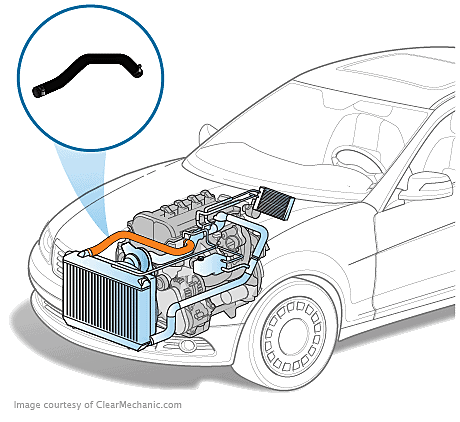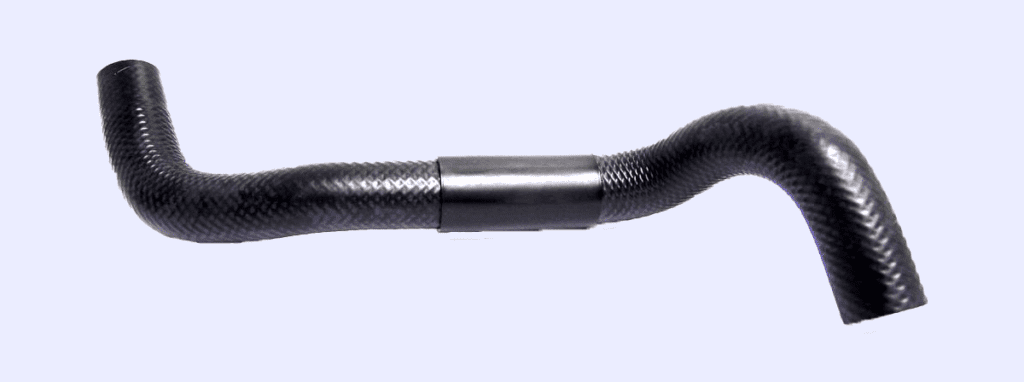Your car’s coolant system is crucial for regulating its engine temperature and preventing overheating. One important component of this system is the coolant hose, which carries coolant from the engine to the radiator and back. In this article, we’ll take a closer look at what a coolant hose is, signs of a faulty hose, and how to replace it.
What is a Coolant Hose?
A coolant hose is a rubber or silicone tube that connects the engine to the radiator and water pump. It carries coolant throughout the engine to help regulate its temperature and prevent overheating.

How Much Will it Cost to Replace a Coolant Hose in Canada?
The cost of replacing a coolant hose in Canada can vary depending on the make and model of your vehicle, as well as the mechanic you choose. On average, you can expect to pay between $150 and $400 CAD for parts and labour. The labour time can take anywhere from 1 to 3 hours depending on the complexity of the repair.
What are the Symptoms of a Faulty Coolant Hose?
The symptoms of a faulty coolant hose can include:
1. Coolant leaks: The most noticeable symptom is visible coolant leaking from the hose, which may pool under the vehicle when parked.
2. Overheating: A damaged or leaking coolant hose can lead to insufficient coolant flow, causing the engine to overheat.
3. Low coolant levels: If a coolant hose is leaking, you may notice low coolant levels in the expansion tank or radiator.
4. Swollen or soft hoses: A coolant hose may become swollen, soft, or spongy due to chemical damage, ECD, or exposure to oil and other fluids.
5. Brittle or cracked hoses: Age, wear, and heat exposure can cause hoses to become brittle, leading to visible cracks or breaks.
6. Collapsed hoses: A hose may collapse due to internal blockage or damage, restricting coolant flow and leading to overheating.
7. Check engine light or temperature warning light: A faulty coolant hose causing engine overheating may trigger the check engine light or a temperature warning light on the dashboard.
8. Poor performance and reduced fuel efficiency: A malfunctioning cooling system, including a faulty coolant hose, can negatively impact engine performance and fuel efficiency.
How Long Does a Coolant Hose Last?
A coolant hose can last anywhere from 4 to 10 years or longer, depending on driving habits and maintenance. However, it’s important to regularly inspect the hoses for wear and tear and address any issues promptly to avoid further damage to the engine and other components.
How Does a Coolant Hose Become Defective?
A coolant hose can become defective due to several factors:
1. Age and wear: Over time, coolant hoses can deteriorate due to constant exposure to heat, pressure, and chemicals in the coolant. This can result in the hoses becoming brittle, cracking, or developing pinhole leaks.
2. Mechanical damage: Impact from road debris, engine vibrations, or improper installation can cause physical damage to the hoses, such as punctures, tears, or kinks.
3. Chemical damage: Contaminated coolant or the use of improper coolant types can cause chemical reactions that lead to the breakdown of the hose material.
4. Electrochemical degradation (ECD): Coolant hoses can suffer from ECD, a phenomenon where the coolant and hose materials interact, leading to the deterioration of the hose from the inside out.
5. Clamping issues: Over-tightened or damaged hose clamps can cause excessive stress on the hose, leading to potential leaks or failure.
6. Exposure to oil and other fluids: Contact with engine oil, fuel, or other chemicals can weaken the hose material, causing it to degrade and eventually fail.
How Can a Faulty Coolant Hose Affect Other Systems in the Car?
• Engine overheating: A leaking or damaged coolant hose can result in coolant loss, leading to insufficient cooling and potential engine overheating.
• Damage to other engine components: Overheating can cause damage to the head gasket, cylinder heads, and other engine components, resulting in expensive repairs.
• Reduced heater efficiency: A faulty coolant hose may compromise the proper flow of coolant to the heater core, resulting in reduced cabin heating performance.
• Transmission issues: In some vehicles, the coolant is responsible for cooling the transmission. A faulty coolant hose could negatively impact the transmission’s operation and lifespan.
• Increased emissions: Overheating can cause the engine to run less efficiently, leading to increased emissions and potential problems with emission control systems.
Is it Safe to Drive with a Faulty Coolant Hose?
Driving with a faulty coolant hose can be risky, as it plays a crucial role in maintaining the proper temperature of your vehicle’s engine. Coolant hoses transport coolant between the engine, radiator, and heater core to ensure efficient heat transfer and prevent the engine from overheating. A damaged or leaking hose can result in coolant loss, leading to the engine running at higher temperatures and potentially causing severe damage.
If you suspect that your coolant hose is faulty, it is important to address the issue as soon as possible to prevent further complications. Continuing to drive with a compromised hose may lead to engine overheating, head gasket failure, warped cylinder heads, or even complete engine failure. It is best to have the coolant hose inspected and replaced by a professional mechanic to ensure the safety and reliability of your vehicle.
How Can I Make My Coolant Hose Last Longer?
Here are some tips to help prolong the life of your coolant hose:
• Regular maintenance: Follow the manufacturer’s recommended maintenance schedule to ensure all components, including the coolant hose, are in good condition.
• Avoid extreme conditions: Avoid driving in extreme temperatures and conditions whenever possible, as these can cause damage to the hose and other components.
• Address issues promptly: If you notice any signs of a faulty coolant hose, such as leaks or reduced engine performance, address them promptly to avoid further damage.

Conclusion: Coolant Hose Replacement
The coolant hose is an essential component of your car’s coolant system, and a faulty hose can cause significant engine damage and safety hazards. If you notice any signs of a faulty coolant hose, it’s important to address the issue promptly to avoid further damage. With proper maintenance and care, you can help prolong the life of your coolant hose and keep your car running smoothly.
Next Steps
Book Your Coolant Hose Replacement Service
The service most frequently booked by those who read this article is Coolant Hose Replacement. Uchanics’ expert technicians make the process even more convenient by bringing the service right to your doorstep. We perform this job at your home or office, covering over 40 cities in Ontario, including Toronto, Mississauga, Brampton, Oshawa, Ajax, Scarborough, and more. Our commitment to excellence has earned us more than 700 glowing 5-star reviews. Choose Uchanics for your Coolant Hose Replacement and experience unparalleled convenience and top-quality service.
